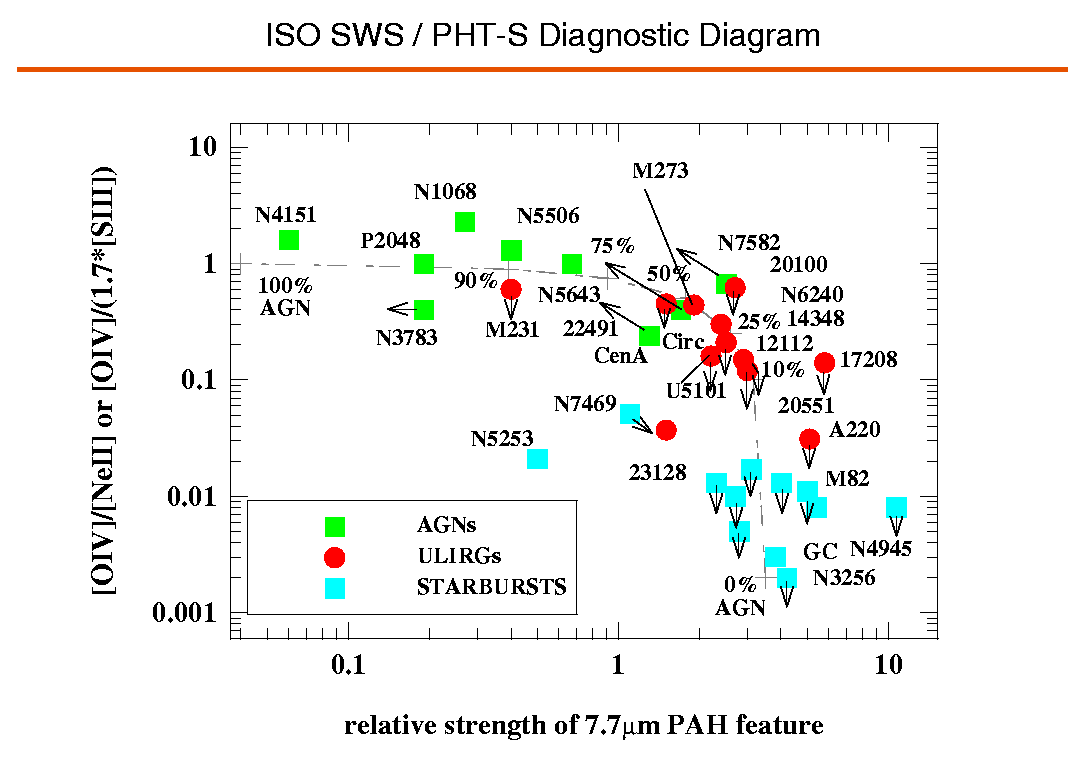What Powers Ultra-Luminous IRAS Galaxies ?
R. Genzel, D. Lutz, E. Sturm, E. Egami, D. Kunze, A.F.M. Moorwood,
D. Rigopoulou, H.W.W. Spoon, A. Sternberg, L.E. Tacconi-Garman,
L. Tacconi and N. Thatte
Abstract:
We present an ISOSWS and ISOPHOT-S, mid-infrared spectroscopic survey of
fifteen ultra-luminous IRAS galaxies (LIR >10^12 Lo). We combine the survey
results with a detailed case study, based on arcsecond resolution, near-IR
and mm imaging spectroscopy, of one of the sample galaxies (UGC 5101). We
compare the near- and mid-IR characteristics of these ultra-luminous galaxies
to ISO and literature data of thirty starburst and active galactic nuclei
(AGN), template galaxies.
We find that:
- 70 to 80% of the ultra-luminous IRAS galaxies in our sample are
predominantly powered by recently formed massive stars. 20 to 30% are powered
by a central AGN. These conclusions are based on a new infrared 'diagnostic
diagram' involving the ratio of high to low excitation mid-IR emission lines
on the one hand, and on the strength of the 7.7(m PAH feature on the
other hand.
- at least half of the sources probably have simultaneously an active
nucleus and starburst activity in a 1-2 kpc diameter circum-nuclear disk/ring.
- the mid-infrared emitting regions are highly obscured (AV(screen)~5 to
50 or AV(mixed)~50 to 1000). In a model where star forming regions and dense
molecular clouds are fully mixed the ISO derived, V-band dust extinctions
approach the dust column densities inferred from CO mm measurements. After
correction for these extinctions, we estimate that the star forming regions
in ULIRGs have ages between 107 and 108 years, similar to but somewhat larger
than those found in lower luminosity starburst galaxies.
- in the sample we have studied there is no obvious trend for the AGN
component to dominate in the most compact, and thus most advanced mergers.
Instead, at any given time during the merger evolution, the time dependent
compression of the circum-nuclear interstellar gas, the accretion rate onto
the central black hole and the associated radiation efficiency may determine
whether star formation or AGN activity dominates the luminosity of the system.
Keywords: galaxies: stellar content - galaxies: starburst -
galaxies: nuclei - infrared: sources - infrared: galaxies - stars: formation
Status: to appear in Astrophysical Journal (accepted)
Address: mailto:
genzel@mpe-garching.mpg.de
 Full text
(Gzip'd tar file of PostScript files)
Full text
(Gzip'd tar file of PostScript files)

Figure: ISO SWS/PHOT-S Diagnostic Diagram

![[MPE Logo]](http://www.mpe-garching.mpg.de/Icons/back-mpe.gif) MPE HomePage |
IR/SubMM
HomePage |
ISO HomePage |
ISO Preprints
MPE HomePage |
IR/SubMM
HomePage |
ISO HomePage |
ISO Preprints

Last update: 26-Oct-1997 by D. Kunze
mailto:
isodata@mpe-garching.mpg.de
![]() Full text
(Gzip'd tar file of PostScript files)
Full text
(Gzip'd tar file of PostScript files)
![]()
![]() MPE HomePage |
IR/SubMM
HomePage |
ISO HomePage |
ISO Preprints
MPE HomePage |
IR/SubMM
HomePage |
ISO HomePage |
ISO Preprints
![]()